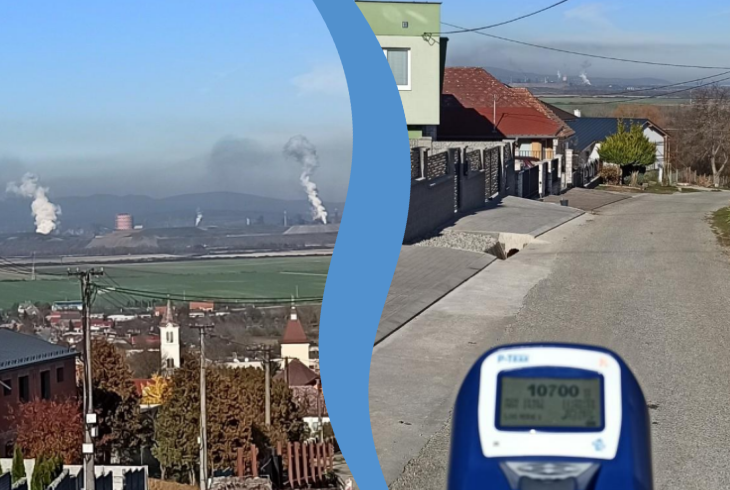

New
Measuring Ultrafine Particles from Industrial Activity: Does Pollution Affect Surrounding Communities?
20. 05. 2025
![]() Air
Air
In early November 2024, an indicative measurement of air pollution caused by ultrafine particles (UFP – ultrafine particles) was carried out in locations in western and eastern Slovakia, focusing on major sources of air pollution. The aim was to determine to what extent industrial activity contributes to UFP air pollution in Slovak agglomerations – Bratislava and Košice. The measurements focused on industrial emissions were carried out within the activities of the Populair project in cooperation with the civic association CEPTA.

Industry is among the main sources of air pollution, although in recent decades emissions have decreased significantly thanks to EU legislation, modernization of technologies, and the closure of some older plants. In Slovakia, traditional industries include metallurgy, iron and steel production, coke and refinery products, chemical production, construction materials, and more. During industrial operations, particulate matter and sulfur oxides are primarily released into the atmosphere through material handling, storage, and transport.
Measurements by CEPTA were carried out using a P-Trak Ultrafine Particle Counter from TSI, model 8525, which measures UFP with a diameter of 0.02 – 1 µm as the number of particles per cm³ of air.
Košice Steelworks
On 9 November 2024, indicative measurements were taken in the villages of Haniska, Bočiar, Perín – Chym, and Veľká Ida, located near the Košice steelworks, to assess the extent to which the plant influences UFP concentrations in surrounding communities. Concentrations varied significantly, influenced by other sources such as local heating and traffic.
Depending on wind direction, however, it was observed that the steelworks’ operation may contribute to doubling UFP concentrations in adjacent villages compared to unaffected or minimally affected background levels.
Bratislava Refinery
On 12 November 2024, indicative measurements were carried out in Podunajské Biskupice (Bratislava) and the nearby village of Rovinka, both located close to the Bratislava refinery. When the wind did not carry refinery emissions over these sites, only slightly elevated UFP concentrations were recorded, mainly due to local heating.
However, identical measurements in 2022, when wind carried refinery smoke directly into residential areas, indicated that refinery operations could increase UFP concentrations in nearby areas by 4 to 8 times compared to background levels measured in Bratislava’s Rača district. During these periods of elevated UFP, odors were also noticeable.
How to protect yourself from air pollution?
Monitor local air quality via www.shmu.sk or www.dnesdycham.sk.
When air quality is poor or very poor, follow recommendations: limit strenuous outdoor activity, reduce time spent outside, keep windows closed, and use a respirator – especially important for sensitive groups (children, pregnant women, the elderly, people with chronic conditions).
Help improve air quality with everyday decisions about transport, heating, and other activities.
Ultrafine particles (UFP)
Ultrafine particles are particles with a diameter of 100 nm (0.1 µm) or less. They can easily penetrate from the respiratory system into the bloodstream and be transported to sensitive organs, including the central nervous system. Their presence in the blood can affect its properties and functions. They are highly reactive and may contain heavy metals and toxic substances.
The mass of UFP is negligible compared to PM10 and PM2.5, so for health impact assessment, particle count and size distribution are more relevant. Unlike PM10 and PM2.5, which are regulated with clear standards, UFP are not yet included in Slovak national legislation on air quality. However, the new EU Directive on ambient air quality and cleaner air, adopted in October 2024, lists UFP as a new pollutant that must be monitored. The requirements for monitoring sites vary depending on the size and population of each Member State.
Air quality assessment
Air quality is influenced by emissions from industry, transport, households, and other natural and anthropogenic sources, as well as dispersion conditions such as meteorology and topography. Air quality monitoring stations of the Slovak Hydrometeorological Institute (SHMI), operated under Decree No. 250/2023 on air quality, are located 1.5 (breathing zone) to 4 meters above ground. Pollutants have limit or target values for protecting human health, and some allow a defined number of exceedances. SHMI assesses air quality using continuous measurement, modeling, forecasting, and estimation, with results published annually in the Air Quality Report.
The Centre for Sustainable Alternatives (CEPTA) was founded in 2005 to support and implement activities promoting sustainability principles. Within the LIFE IP – Improving Air Quality project, CEPTA measures ultrafine particles in the air to raise public awareness about their health impacts and present measures to reduce pollution.
The report on ultrafine particle measurements from industrial activity is available here:
CEPTA – Industrial UFP Report (April 2025)
More information on traffic-related UFP measurements:
Measuring ultrafine particles shows how sensitive air is to change – how can we influence it?
More information on local heating-related UFP measurements:
Measuring ultrafine particles from local heating – how to reduce household emissions











